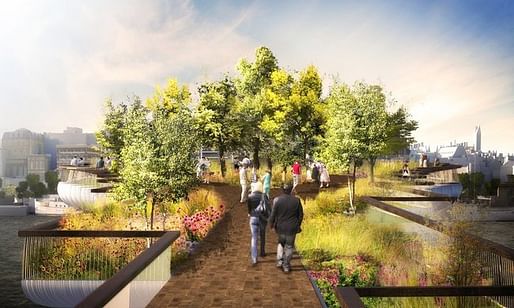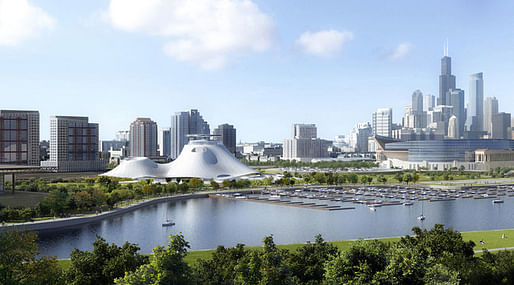
As the year comes to a close, we're taking the opportunity to reflect on its defining moments. 2016 has been, for many of us, a pretty tough year—and the architecture community hasn't been immune to its trials and tribulations. Here's a round-up of some of the biggest controversies, debacles, and fiascos of the year.

The Boorish Border Wall Competition
Long before Donald Trump went from long-shot presidential candidate to President-elect, a controversial competition was launched to design the border wall that remains one his major campaign promises. Initiated by the mysterious Third Mind Foundation, the competition provoked immediate and intense backlash because of its asserted “neutrality” in regards to a proposal considered by many to represent the heights of xenophobia.

The Great Tokyo Olympic Stadium Debacle
This debacle actually began in 2015, but it continued well into 2016. Zaha Hadid Architects won a competition to design the National Stadium for the 2020 Tokyo Olympics and proceeded to spend three years developing the project. Then, in summer of 2015, Prime Minister Shinzo Abe announced that the design was being dropped over concerns that the costs were running too high. ZHA blamed the cost overrun on the Japanese contractor market and even put out a video plea to keep the design. But the design was still abandoned and Kengo Kuma was chosen to replace ZHA. Flash-forward to early 2016 and the controversy was still raging. Allegedly, the Tokyo Olympics refused to pay ZHA for the work they had done—and some even accused Kuma of copying elements of Hadid’s original design.

A Moat for the Washington Redskins
Everyone loves a good tailgate (okay, I haven’t actually been to one before, but I imagine they’re fun), so why not amp up the experience? That, it seems, was the idea behind BIG’s stadium design for Washington D.C.’s disgracefully-named football team, the Redskins. But for many, the design’s major selling point—a moat that connects to the nearby Anacostia River—was a ridiculous gimmick.

Pritzkerian Nepotism
2016 was a big year for the Chilean architect Alejandro Aravena. Not only did he get to direct the Venice Biennale, he also won the Pritzker prize. The only problem? He served on the Pritzker jury for the previous seven years. We discussed the potential conflict of interest with Pritzker's Executive Director on the Archinect Sessions podcast.

The Rise of “PC” Culture
This one’s a bit hard to sum up since it blurs into a wider cultural discussion around what is “politically correct” language, what is censorship, and what is, well, structural violence—all big topics in this post-election climate. But in the rarified halls of the architecture blogosphere, the conversation surfaced, in particular, around the Venice Biennale, curated this year by Alejandro Aravena. Titled “Reporting from the Front”, the Biennale focused on architecture that “makes a difference”. For some practitioners, however, the Biennale was more a showcase of architectural guilt than excellence.

Heatherwick’s (Privatized, Heavily-Surveilled, and Ridiculously Expensive) Garden Bridge for London
One of former-Mayor of London, current-Secretary of State for Foreign Affairs Boris Johnson’s major initiatives during his tenure as head honcho of London, the Garden Bridge was promised to be a verdant and iconic piece of infrastructure for the city. But optimism for the project quickly drained. Estimated costs amounted to what critics claimed could fund 30 new parks—but that wasn’t even the worst of it. Submitted plans detailed an extensive surveillance apparatus as well as sponsorship in the form of prominent advertisements by the media company Sky. And, besides all that, the whole thing is pretty gimmicky, said many a critic.

Schumacher Veers Ever Further Right
Patrik Schumacher, the current head of Zaha Hadid Architects, is as well-known for his parametricist theories as for his anarcho-capitalist politics, expressed through Facebook, talks and essays. Recently, Shumacher gave a talk at the World Architecture Festival where he pushed his ideas even further to the right, arguing for the abandonment of social housing and even paving over Hyde Park. Needless to say, many architects disagree with the idea—including the estate of Zaha Hadid, and Zaha Hadid Architects itself.

British Transport Minister Rails Against Brutalist Rail Stations
In a rather orotund letter, British Minister for Transport John Hayes decried a “cult of ugliness” gripping architecture, in particular transit architecture. He called for a “return” to a (highly subjective) idea of “elegance, style and beauty”, and vowed to weaponize his authority to achieve it. Some agreed, some did not. Debate ensued.

The Sharing Economy Catches More Heat
AirBNB, the online platform that facilitates the conversion of a home or apartment into a rentable asset, faced a lot of criticism in 2016. Evidence is mounting that the service exacerbates already-unprecedented wealth disparities, raises rents in already-unaffordable cities, and correlates to an increase in evictions. It’s also been shown to be racist.

Oh Gentrification, Where Aren’t Thou?
As cities around the world grapple (or don’t) with mass housing shortages, activists are fighting to stay in neighborhoods that many of them have lived in for generations, but which are rapidly experiencing an influx of capital. In some cases, the sharing economy is put on the hot seat; in others, artists. But while it’s hard to argue that people aren’t being displaced, some urbanists assert that the discourse around ‘gentrification’ is reductive and doesn’t help anyone. Others contend that said urbanists are splitting hairs as people’s lives are put on the line.

The Museum Without a Home
Ever since Bilbao experienced a boom from Frank Gehry’s Guggenheim, many cities have been quick to jump on the bandwagon, clamoring for an architectural icon. But unfortunately, few have received returns on their investments. It’s in this context that George Lucas’ museum project has found itself the object of major pushback from Chicago activists who didn’t want the museum to take up prized lakefront land. San Francisco and LA, on the other hand, are proving more welcoming.

AIA-gate
Shortly following the election of Donald Trump, the CEO of the American Institute of Architects, Robert Ivy, issued a statement on behalf of all its members vowing to work with the controversial president-elect. All its members, however, are not down to work with Trump. Cue a huge social media firestorm collected under the hashtag #NotMyAIA. This prompted the AIA to release a video apology, followed by another statement. But for many, this wasn’t enough, so they canceled their membership or resigned from their posts.
2 Comments
My comment addresses your overall Luke-warm texting style! Why, what I am writing is in gray and not black ink? Are you saving some on the cost of ink, or are you hesitant to give a clear picture? I cannot imagine N. Y. Times publishing in grays, so why do you? JUST ASKING, thanks.
Wow?! What does that mean?
Block this user
Are you sure you want to block this user and hide all related comments throughout the site?
Archinect
This is your first comment on Archinect. Your comment will be visible once approved.